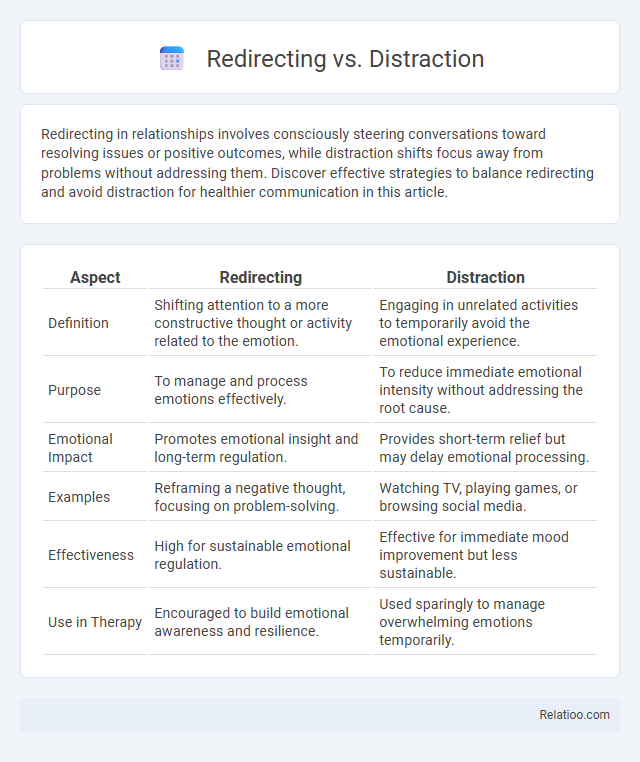Redirecting in relationships involves consciously steering conversations toward resolving issues or positive outcomes, while distraction shifts focus away from problems without addressing them. Discover effective strategies to balance redirecting and avoid distraction for healthier communication in this article.
Table of Comparison
| Aspect | Redirecting | Distraction |
|---|---|---|
| Definition | Shifting attention to a more constructive thought or activity related to the emotion. | Engaging in unrelated activities to temporarily avoid the emotional experience. |
| Purpose | To manage and process emotions effectively. | To reduce immediate emotional intensity without addressing the root cause. |
| Emotional Impact | Promotes emotional insight and long-term regulation. | Provides short-term relief but may delay emotional processing. |
| Examples | Reframing a negative thought, focusing on problem-solving. | Watching TV, playing games, or browsing social media. |
| Effectiveness | High for sustainable emotional regulation. | Effective for immediate mood improvement but less sustainable. |
| Use in Therapy | Encouraged to build emotional awareness and resilience. | Used sparingly to manage overwhelming emotions temporarily. |
Understanding Redirecting vs Distraction
Understanding the difference between redirecting and distraction is crucial for effective behavior management. Redirecting involves guiding your focus or actions toward a positive or appropriate alternative, helping you develop better coping strategies, while distraction simply diverts attention away without addressing the underlying issue. Mastering redirecting ensures long-term benefits by fostering constructive habits rather than temporary relief through distraction.
Core Principles of Redirecting
Redirecting emphasizes guiding Your attention or behavior toward a constructive alternative, leveraging empathy and clear communication to address the root cause of distraction or disturbance. Core principles of redirecting include understanding the individual's needs, maintaining patience, and providing positive reinforcement to encourage desired actions. Unlike mere distraction, redirecting fosters purposeful engagement, ensuring long-term behavioral improvement rather than temporary diversion.
Key Elements of Distraction Techniques
Distraction techniques primarily involve diverting Your attention away from stressors or pain by engaging other sensory or cognitive pathways, such as focusing on a specific object, sound, or task. Key elements include the intensity of engagement, the sensory modality targeted (visual, auditory, tactile), and the individual's active participation, which enhances the effectiveness of distraction in managing discomfort or negative emotions. Understanding these components helps you apply distraction strategically, distinguishing it from simple redirection, which shifts focus more broadly without the immersive engagement characteristic of distraction techniques.
Benefits of Redirecting Behavior
Redirecting behavior involves guiding attention or actions toward a positive or desired outcome, enhancing emotional regulation and reducing conflicts effectively. Unlike distraction, which temporarily diverts focus without addressing underlying issues, redirecting helps build problem-solving skills and promotes long-term behavioral improvements. This approach supports consistent behavioral management in educational, therapeutic, and parenting contexts by fostering constructive engagement and resilience.
When to Use Distraction in Practice
Distraction is most effective in practice when immediate emotional regulation is needed, particularly during moments of acute stress or anxiety, redirecting attention away from distressing stimuli to prevent escalation. Unlike redirection, which involves guiding focus toward a constructive or preferred activity, distraction primarily shifts attention temporarily without changing the main goal or behavior. Use distraction strategically in clinical settings or everyday situations where a brief mental break helps stabilize mood before employing longer-term coping mechanisms or redirection techniques.
Comparing Redirecting and Distraction Outcomes
Redirecting involves guiding Your attention or behavior towards a positive or intended task, leading to constructive outcomes such as increased focus and improved productivity. Distraction diverts attention away from the primary task without a clear alternative goal, often causing decreased efficiency and fragmented concentration. Comparing these outcomes reveals that redirecting supports goal achievement by maintaining engagement, whereas distraction typically results in lost time and reduced task completion.
Common Situations for Redirecting
Redirecting is commonly applied in situations where a person, often a child or someone with cognitive challenges, exhibits undesirable behavior, such as anger or frustration, and needs gentle guidance toward a positive activity. Distraction typically occurs when immediate change of focus is required to interrupt negative emotions or behaviors, often through engaging stimuli like toys or conversation. Redirecting focuses on providing alternative, appropriate options that teach coping mechanisms and promote constructive engagement in everyday scenarios, such as classroom disruptions or emotional outbursts at home.
Pitfalls of Relying on Distraction
Relying solely on distraction to manage attention can lead to decreased productivity and unresolved stress, as your mind continually shifts without addressing underlying issues. Distraction often results in fragmented focus, making tasks take longer and increasing the likelihood of errors. Your ability to effectively redirect attention ensures better control over cognitive resources, promoting sustained concentration and emotional regulation.
Integrating Redirecting and Distraction Strategies
Integrating redirecting and distraction strategies enhances behavioral management by shifting attention from undesirable actions to positive alternatives through planned interventions. Redirecting involves guiding focus toward a relevant, appropriate activity, while distraction temporarily diverts attention to prevent escalation. Combining these techniques effectively supports emotional regulation, reduces conflict, and fosters adaptive responses in challenging situations.
Building Effective Behavior Management Plans
Redirecting involves guiding a student's attention from undesirable behaviors to appropriate activities, promoting positive engagement and reducing disruptions. Distraction temporarily diverts attention but often fails to address the underlying cause of the behavior, making it less effective for long-term behavior change. Building effective behavior management plans prioritizes redirecting strategies by incorporating clear expectations, consistent consequences, and targeted interventions that reinforce desired behaviors and foster self-regulation.

Infographic: Redirecting vs Distraction
 relatioo.com
relatioo.com